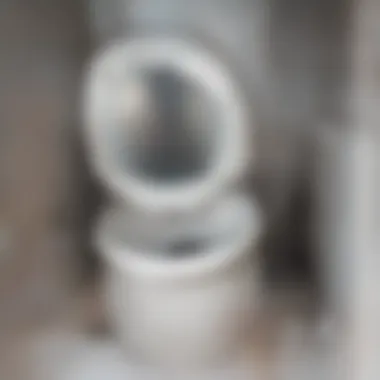Effective Chemicals for Unclogging Toilets


Intro
Dealing with a clogged toilet can be a frustrating experience. Understanding the effective chemicals that can clear blockages is vital for every homeowner. This guide explores the chemicals that are most commonly used for unclogging toilets, along with their advantages and disadvantages. By tackling this topic, we aim to equip you with the information necessary to maintain your plumbing effectively.
To fully appreciate the options available in the market, it's essential to look at both commercial products and natural alternatives. The safety of these chemicals, their environmental impact, and usage guidelines are critical factors that must be considered. Homeowners deserve clarity and guidance when choosing the right unclogging solution, ensuring their choices are informed.
What to Expect
This guide will cover the following key points:
- The types of chemicals used for unclogging toilets
- Effectiveness and methods of application
- Safety precautions and environmental considerations
- Comparisons of commercial and natural solutions
By synthesizing this information, readers will appreciate the relevance and importance of choosing the right products for toilet maintenance.
Understanding Toilet Clogs
Understanding toilet clogs is essential for addressins a common household issue that can lead to significant inconvenience and expense. Toilets are critical fixtures in any home, and when they do not function properly, it can disrupt daily routines. Being aware of how toilet clogs occur and how they can be identified helps homeowners manage their plumbing systems effectively. This knowledge can prevent minor issues from escalating into major plumbing problems, ultimately saving time and money.
Common Causes of Toilet Clogs
There are various reasons why toilets become clogged. One common cause is the improper disposal of materials. Items such as wipes, paper towels, and feminine hygiene products often do not break down as toilet paper does, leading to blockages. Additionally, excessive toilet paper usage can contribute to clog formation.
Another significant cause is the buildup of mineral deposits over time. This is particularly prevalent in areas with hard water, where calcium and other minerals can accumulate on the interior surfaces of pipes and toilets, restricting flow.
An obstruction in the plumbing vent can also create a clog. The plumbing vent allows air into the system, maintaining proper water flow. If this vent is blocked, it can cause the toilet to siphon improperly and lead to clogs.
Signs of a Clogged Toilet
Identifying a clogged toilet early is important for effective resolution. Here are some clear signs that your toilet may be clogged:
- Slow draining water: If the water takes longer than usual to drain after a flush, it may indicate a developing blockage.
- Gurgling sounds: Unusual noises when flushing can suggest air trapped in the pipes due to a clog.
- Water level fluctuations: A toilet that frequently rises or falls in water level signals potential obstruction.
- Foul odors: Persistent unpleasant smells can emerge from a clogged toilet as waste material decomposes behind obstructions.
Recognizing these signs promptly can facilitate timely attention, preventing minor issues from leading to more complex plumbing problems.
Chemical Options for Unclogging Toilets
To effectively deal with toilet clogs, understanding chemical options is essential. These chemicals can provide a quick fix to the hassle of clogged toilets. Additionally, using the right products reduces the time and effort needed to resolve plumbing issues. The focus here is to give readers an overview of the options available, their benefits, and safety considerations.
Commercial Drain Cleaners
Commercial drain cleaners are a popular choice for dealing with clogged toilets. They come in various formulations and target different types of clogs, making them versatile solutions.
Types of Commercial Products
There are several types of commercial drain cleaners available. Some are caustic, while others are enzymatic or acid-based. Caustic cleaners often contain sodium hydroxide, which can dissolve clogs effectively. Acid-based products, like sulfuric acid, can break down organic material rapidly. Enzymatic cleaners, on the other hand, use enzymes to digest waste, making them typically safer for pipes.
The key characteristic of commercial drain cleaners is their speed. Many users prefer them because they work quickly in emergencies. However, using harsh chemicals can lead to corrosion in pipes over time.
Common Ingredients Used
Common ingredients found in these cleaners include sodium hydroxide, sulfuric acid, and hydrogen peroxide. Sodium hydroxide is effective at breaking down grease and organic material but can be dangerous if not handled properly. Sulfuric acid works faster but can cause damage to plumbing if not used carefully. Hydrogen peroxide is milder and environmentally friendly, making it a safer option for regular maintenance, although it may take longer to work.


The key feature of these ingredients is their effectiveness. They can provide swift results, making them popular among homeowners experiencing sudden clogs. On the downside, their use also raises safety concerns. Proper precautions must be taken to avoid accidents.
Natural Alternatives
Natural alternatives are gaining popularity among eco-conscious individuals. They offer a safer way to unclog toilets without harsh chemicals.
Baking Soda and Vinegar
Baking soda and vinegar provide a simple, effective method for unclogging toilets. This combination reacts chemically to create bubbles that can dislodge minor clogs. The key characteristic is its safety for both the user and plumbing systems. Many people prefer it due to its non-toxic nature.
A unique feature of this method is its accessibility. Almost every household has baking soda and vinegar. However, its effectiveness is often limited to mild clogs, which can be a considerable disadvantage in more severe situations.
Hot Water and Dish Soap
Using hot water and dish soap is another effective natural remedy. The key characteristic is its simplicity and low cost. Dish soap can help lubricate the clog, while hot water can melt and dissolve it.
This method is particularly beneficial for greasy clogs. However, it may take longer to achieve results compared to commercial products, which could be a downside in urgent situations.
In summary, both commercial and natural options have their strengths and weaknesses. Understanding these differences is crucial for choosing the right method for unclogging toilets.
Evaluating Chemical Effectiveness
Evaluating the effectiveness of chemicals used for unclogging toilets is a crucial aspect of plumbing maintenance. Understanding how different chemicals work allows homeowners to make informed decisions. It helps them select the right product for specific problems. This awareness can lead to faster and more effective resolutions to clogs, saving both time and money in the long run.
Factors Affecting Effectiveness
Type of Clog
The type of clog significantly influences the choice of chemical agents. There are generally two types of clogs: soft clogs and hard clogs. Soft clogs are typically made up of organic waste, like toilet paper or human waste. These types are often easier to dissolve with chemicals. On the other hand, hard clogs may consist of foreign objects like toys or large paper items. These require different approaches.
Key characteristic: Soft clogs respond well to commercial drain cleaners featuring enzymes or acids. These chemicals break down organic material effectively. In contrast, hard clogs may necessitate mechanical methods, as chemicals offer limited help. Understanding this distinction is beneficial for homeowners seeking a quick fix to their toilet issues.
The advantage of being aware of the type of clog is the ability to act accordingly. Selecting the wrong type of chemical can lead to wasted time and ineffective results.
Duration of Clog
Duration of clog is also an important factor in evaluating chemical effectiveness. Over time, waste can harden and embed deeper within the plumbing system. Fresh clogs, which are usually only a few hours or a day old, can often be treated more easily than older clogs. When waste has settled and compacted, it becomes more resistant to chemical agents.
Key characteristic: Newer clogs are responsive to a variety of chemical solutions. This is because the materials are still soft and relatively easy to break down. In contrast, long-standing clogs pose a more significant challenge. They often require harsher chemicals or even physical intervention.
This unique feature of aging clogs highlights the importance of timely intervention. Should you delay action, the problem may escalate, leading to more costly repairs.
Comparative Effectiveness of Chemicals
When comparing the effectiveness of different chemical agents, it is essential to consider their active ingredients. For instance, sodium hydroxide found in Drano or Liquid-Plumr is designed for tough jobs. These products are particularly good at breaking down grease or paper. Conversely, natural alternatives like baking soda and vinegar are gentler but may not always clear severe blockages.
To summarize, the evaluation of chemical effectiveness revolves around understanding the type and duration of clogs encountered. Choosing the appropriate chemical accordingly can facilitate better results in unclogging toilets, enhancing the overall plumbing experience for homeowners.
Safety Considerations When Using Chemicals
Using chemicals to unclog toilets can be effective but comes with certain risks. These risks highlight the necessity of understanding how to handle chemical products properly. Safety considerations are vital not only for personal well-being but also for ensuring that the cleaning process does not lead to further damage to plumbing or the environment. Proper precautions ensure that unclogging efforts yield the desired results without creating hazardous situations.


Personal Protective Equipment
When working with chemical agents, personal protective equipment (PPE) is a fundamental aspect of safety. It includes items such as gloves, goggles, and masks. Each of these contributes to minimizing exposure to harmful substances.
- Gloves: Protect your hands from harsh chemicals which can cause irritation or burns. It is important to use chemical-resistant gloves for this task.
- Goggles: Chemical splashes can damage the eyes. Wearing goggles creates a barrier that helps avoid injury.
- Masks: Chemical fumes can be toxic. A mask safeguards the respiratory system against inhalation of volatile compounds that can lead to health issues.
In addition to these basic items, ensuring your clothing is protected is also wise, as splashes can occur during application. By wearing long sleeves and protective footwear, you can further protect your body from unintentional exposure to hazardous agents.
Ventilation and Environmental Safety
Proper ventilation is another critical factor when using chemicals to unclog toilets. Many commercial products release fumes that can build up in enclosed spaces, increasing the risk of inhalation and other health problems.
- Open Windows: If possible, open windows in the bathroom to allow fresh air to circulate. This reduces the concentration of potentially harmful fumes.
- Use Exhaust Fans: Turn on ventilation fans if available. They help draw out contaminated air, improving overall air quality in the space.
- Avoid Confined Spaces: Avoid directing your face towards the toilet bowl when applying chemicals, as this can increase exposure to toxic fumes.
- Limit Household Presence: Keep other household members, especially children and pets, away from the area during and after use. This step minimizes the risk of accidental exposure to hazardous chemicals.
Taking these precautions helps to preserve not only personal health but also the integrity of plumbing systems and the environment. It reduces the risk of chemical interactions that can endanger both the user and the ecosystem.
"Safety with chemicals is not just about personal protection; it's about protecting your environment as well."
Step-by-Step Process of Using Chemicals
Using chemicals for unclogging toilets requires a methodical approach. The importance of a step-by-step process lies in ensuring not just effectiveness, but also safety. By following a defined protocol, users minimize the risk of chemical accidents and increase the likelihood of successful unclogging.
Preparing the Toilet Area
Preparation is the crucial first step before applying any chemical agents to unclog a toilet. Start by ensuring the area around the toilet is clear of any items that could be damaged by spills. Lay down old towels or newspapers to absorb any overflow that may occur during the process. Also, safety is paramount; consider wearing gloves and protective eyewear if the chemical is strong. Ensure that there is adequate ventilation in the bathroom. Open windows and doors to allow fresh air to circulate, reducing any fumes that may arise from chemical reactions. These precautions not only foster a safer environment but also facilitate a smoother application process.
Application of Chemical Agent
Applying the chemical agent effectively demands attention to guidelines provided by the manufacturer. Always read the instructions carefully. If using a commercial drain cleaner, pour the recommended dosage directly into the toilet bowl, trying to target the areas that most likely hold the clog. For natural alternatives, such as a baking soda and vinegar mixture, pour one cup of baking soda followed by one cup of vinegar into the bowl. Allow the chemicals to work for a specified time period, usually around 30 minutes, as this timeframe allows the chemicals to break down the clog. During this time, avoid flushing the toilet to ensure the agent does not wash away prematurely. The method of application can significantly influence the outcome, so it should be executed with precision.
Post-Application Tips
Testing for Clogs
After the application period, testing for clogs is essential. Begin by carefully flushing the toilet to see if the water drains normally. A successful flush typically indicates that the clog has been resolved. If the water does not drain or backs up, this indicates that the clog may still be present. It is advisable to repeat the treatment if need be. This step is beneficial as it allows anyone to check the effectiveness of the chosen method and gauge whether further intervention is necessary.
"Testing for clogs after chemical application is key to confirming if the clog has been resolved and helps decide the next steps."
Maintenance Recommendations
Maintenance recommendations play a vital role in preventing future clogs. After successful unclogging, consider implementing regular maintenance practices. Using enzymatic drain cleaners once a month can help maintain pipes and prevent buildup. Additionally, educate household members about proper disposal practices, such as not flushing non-degradable items. This proactive approach to toilet care not only extends the life of plumbing systems but also minimizes the need for harsh chemicals, fostering a more environmentally friendly approach to maintenance. Regular maintenance is generally seen as beneficial since it can save both time and money in the long run.
By maintaining a routine based on these guidelines, the incidence of clogs should significantly decrease, ensuring a smoother overall functioning of your toilet system.
Environmental Impact of Chemical Agents
Understanding the environmental impact of chemical agents used for unclogging toilets is critical for both homeowners and environmental enthusiasts. Many cleaning products contain harsh substances that can affect not only plumbing systems but also the broader ecosystem. This section aims to delve into the implications of using these chemicals, highlighting their risks, benefits, and sustainable alternatives. By doing so, homeowners can make informed choices that align with environmentally responsible practices.
Biodegradability of Chemicals
Biodegradability refers to the ability of a substance to be broken down by microorganisms into natural components. Chemicals used in toilet unclogging, especially commercial drain cleaners, vary in their biodegradability. Some products, such as those containing bleach or strong acids, do not degrade easily, leading to a buildup of harmful substances in wastewater systems.


- Environmental Risks: Non-biodegradable chemicals can accumulate in the environment, posing risks to wildlife and plants.
- Sustainable Choices: Opting for biodegradable cleaners, such as those based on natural enzymes or plant extracts, can significantly mitigate these risks. These products usually break down into harmless substances, making them safer for the ecosystem.
Homeowners should consider how the products they choose affect not only their plumbing but also local water sources and wildlife.
Effects on Plumbing and Ecosystems
The effects on plumbing systems and ecosystems can vary significantly depending on the type of chemicals used. Strong chemicals can corrode pipes and fittings, potentially leading to expensive repairs and replacements. For example, sodium hydroxide can be effective at break down clogs but may also harm older plumbing materials.
On the ecological side:
- Harm to Aquatic Life: When harsh chemicals enter water bodies, they can disrupt aquatic ecosystems, harming fish and other wildlife.
- Contamination of Drinking Water: Chemical residues can find their way into the drinking water supply, posing health risks to both humans and animals.
To mitigate these impacts, using natural alternatives or less harmful chemicals is advisable. Avoiding products with toxic ingredients can significantly benefit plumbing longevity and protect ecosystems. Seeking methods that emphasize sustainability not only ensures effective clog removal but also aligns with a broader commitment to environmental responsibility.
"The choice of chemical agents represents not just a decision on unclogging toilets, but an investment in the health of plumbing systems and the environment."
By being mindful of the environmental impact of chemical agents, consumers can lead the way to a better future.
Preventive Measures for Toilet Maintenance
Maintaining a toilet effectively goes beyond resolving existing clogs. It is vital to implement preventive measures to reduce the frequency of blockages and extend the lifespan of the plumbing system. Regular maintenance is the cornerstone of toilet hygiene. Neglecting it can lead to not just clogs, but also more severe plumbing issues, which may be costly to repair. Understanding and adopting preventive practices can save homeowners not just money but also stress.
Regular Care and Maintenance
Routine checks and cleanings are essential for a properly functioning toilet. This task can be simple yet effective. Here are key practices for regular care:
- Cleaning the Toilet Bowl: Use appropriate cleaning agents to keep the bowl free of stains. A clean toilet is less prone to buildup.
- Inspecting for Leaks: Check around the base and connections for signs of leakage. Early detection can prevent more extensive damage.
- Flushing Regularly: Ensure that the toilet is flushed at least once a day, even if not in frequent use. This helps prevent stagnation and mineral buildup.
By conducting these routine tasks, homeowners can significantly reduce the likelihood of future clogs and enhance the toilet's efficiency.
Identifying Potential Issues Early
Being vigilant about identifying potential plumbing problems can save both time and resources. Homeowners should keep an eye on the following signs that indicate trouble ahead:
- Unusual Sounds: Gurgling noises can suggest that air is trapped in the pipes, signaling a buildup.
- Slow Drainage: If water does not leave the bowl promptly, this may indicate a deeper clog developing.
- Frequent Clogs: An increasing frequency of clogs often points to an unresolved issue within the plumbing system.
"Addressing issues at their onset can minimize escalated problems later, saving money on repairs and full service calls."
Identifying these early warning signs allows homeowners to take immediate action, thus preventing more severe plumbing issues and costly repairs.
When to Seek Professional Help
Understanding when to seek professional help for toilet clogging situations is essential for homeowners who wish to maintain their plumbing systems effectively. While many clogs can be tackled with home remedies and chemical agents, some issues go beyond typical homeowner capabilities. Recognizing these issues early can prevent further damage and costly repairs, maintaining the overall health of your plumbing.
Indicators of Severe Clogging
Several signs may indicate that the clog is more serious and requires a professional plumber's attention. These indicators include:
- Frequent Clogs: If your toilet frequently clogs even after using chemical treatments or natural remedies, it might point to a deeper issue in the plumbing system.
- Multiple Fixture Issues: If more than one plumbing fixture in your home is draining slowly or backing up, this may signal a larger blockage in the main sewer line rather than just an isolated toilet problem.
- Persistent Odors: Unpleasant smells around or in the bathroom can indicate sewage backup caused by a blockage further down the line. This is a health hazard that should prompt immediate professional evaluation.
- Water Level Fluctuations: If the water levels in your toilet bowl fluctuate unexpectedly, this can be a sign of an obstruction in the drain that may need professional tools to resolve.
It is crucial to react quickly to these symptoms to avoid worsening the situation. The longer one waits, the more complex and expensive the repairs could become.
Choosing the Right Plumber
When it becomes necessary to hire a plumber, the choice of the right professional is vital. Homeowners should consider the following factors to ensure they select someone who is qualified and reliable:
- Verify Credentials: Ensure the plumber is licensed and insured. This protects you from liability should an accident occur during the job.
- Experience with Clogs: Look for plumbers who specialize in dealing with toilet and drain issues. They will have the necessary skills and tools to diagnose and fix the problem effectively.
- Reviews and Referrals: Check online reviews or ask for recommendations from friends or family. A trustworthy plumber will have good feedback from previous clients.
- Written Estimates: Request a written estimate before work begins. This protects you from unexpected costs and helps you understand the potential expenses associated with the repair.
By being informed and proactive, homeowners can make better decisions regarding plumbing issues, ensuring the health of their home and plumbing systems.





